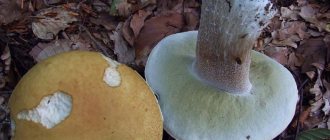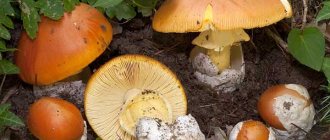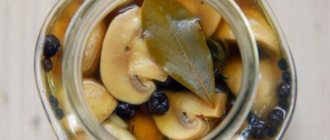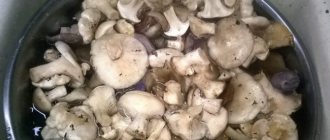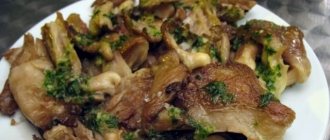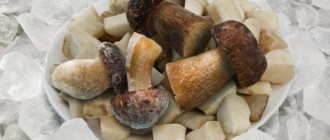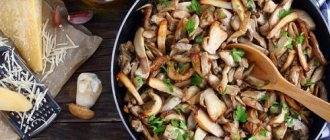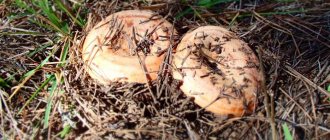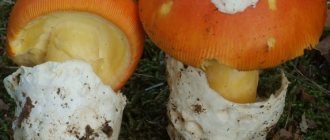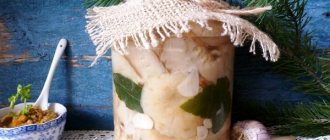Porcini mushroom is the most honored guest in every kitchen. This delicacy is pleasant not only to eat, but also to collect. Its distribution area is quite large, and its taste is excellent. In addition, the porcini mushroom has an impressive size, which makes it a desirable trophy in the basket of any mushroom picker. A special product requires special preparation. “How to cook porcini mushrooms?” - ask cooks who are not entirely confident in their abilities. This article is intended for everyone who wants to understand this issue.
Taste qualities
Everyone has probably heard about the valuable nutritional and sometimes even medicinal qualities of porcini mushrooms. However, boletus mushrooms have gained true love and popularity due to their excellent culinary properties. The bright aroma and distinct taste of these mushrooms make them an excellent product for preparing individual dishes or adding as an ingredient to richer dishes. What kind of dishes are not prepared from boletus mushrooms! They are consumed salted, stewed, fried, pickled and baked. The porcini mushroom, the recipes for which are discussed in this article, is equally good in any version. And its amazing aroma, like no other, can highlight the taste properties of fried chicken, baked beef, good buckwheat porridge or stewed lamb. On cold winter evenings, pickled or salted boletus will be a welcome guest at any festive feast.
Similar species and false look-alikes
During a “silent hunt”, the ability to recognize each individual type of mushroom and distinguish it from similar edible species is of great importance. But the most important thing is to learn to distinguish it from inedible and poisonous mushrooms that are similar in appearance, which can harm not only health, but sometimes even human life.
How to distinguish a porcini mushroom
Although this species has quite remarkable external characteristics, there are nevertheless quite a lot of species similar to the white mushroom with which it can be confused when collected. For the most part, these are the closest related species of porcini mushroom - representatives of the boletus or boletus genus. Among them there are both conditionally edible and non-edible, toxic and poisonous.
Each mushroom has its own distinctive characteristics. Here, first of all, you should carefully study the photo and botanical description of the porcini mushroom and each of the species similar to it. But there is also a general difference due to which this species can be recognized already at the preliminary stage - it is the white or light yellow color of the pulp, which does not change when cut, pressed, or during any type of culinary processing, including drying.
Similar edible species
Speckled Oak - Boletus erythropus
Another name is boletus boletus. The mushroom is conditionally edible. The distinctive features of the white mushroom are:
- The cap is voluminous, fleshy, but does not have a clear shape. The edges are wavy.
- When you press on the edge of the cap, it darkens.
- The color of the flesh of the cap is yellowish, bright yellow, the legs are reddish, brownish. When cut or broken, it quickly changes to blue, greenish-blue.
- Unlike the porcini mushroom, there is no characteristic mesh on the stem. The leg is also covered with red scales.
- Among other habitats, it can also grow in swampy areas, where the white mushroom is practically not found.
Information! The fruiting season of speckled oak is May-October. It grows most abundantly in July.
Olive-brown oakberry – Boletus luridus
Also a double of the porcini mushroom is the olive-brown oak mushroom. Another name is common oak. The mushroom is edible. Unlike porcini mushroom:
- When you press on the cap, it darkens.
- The color of the flesh of the cap is yellowish, at the base of the stem it is reddish, red. When cut or broken, it first changes to blue and then brown.
- Between the flesh of the cap and the hymenophore there is a pigment layer of the red flower, noticeable upon cross-section.
- The color of the leg is yellow-orange, in the lower part it is red-brown.
- The leg is covered over its entire surface with a convex brownish-red mesh with elongated loops.
Information! The olive-brown oak tree bears fruit from May to September.
Polish mushroom – Boletus badius
Some classifications place this species in the genus Xerocomus or Imleria. Another name is Polish porcini mushroom, Pansky mushroom. The mushroom is edible. Like porcini mushroom, it has high taste qualities. The distinctive features of this type are as follows:
- The color of the pulp is whitish, yellowish. When the cap is cut, it first turns blue, then becomes light again. In the leg it first turns blue, then turns brown.
- When you press on the tubular layer, it turns blue.
- The stem is covered with red-brown fibers, and the porcini mushroom has a light mesh pattern.
- Compared to the porcini mushroom, it is noticeably smaller: the diameter of the cap is on average 4-14 cm. The stem is thinner: height - 4-12 cm, thickness - 1-4 cm.
Information! The Polish mushroom grows from June to November.
Poisonous doubles
Unfortunately, the porcini mushroom has a lot of dangerous doubles that can harm human health and even life and with which it can be confused when collected.
Gall mushroom – Tylopilus felleus
Belongs to the genus Tylopilus of the Boletaceae family. Other names: false porcini mushroom, false boletus, bitterling. Inedible.
The mushroom is not poisonous, but it is also not suitable for food, since the taste of its pulp is very unpleasant, bitter, acrid, and does not disappear when cooked, but only intensifies. Even a small piece of a false porcini mushroom can ruin the entire mushroom dish or preparation.
The differences between the white fungus and the gall fungus are as follows: the latter
- The hymenophore (lower part of the cap) is white in very young specimens, then as it grows it becomes pinkish, dirty pink. Turns red when pressed.
- The leg is covered with a dark mesh pattern, in contrast to the porcini mushroom, which has a light mesh.
- The pulp is white, when cut it changes to pink, pink-brown, reddish.
- The taste is bitter.
- It can grow on the roots of not only living trees, but also near rotten stumps and on rotten wood.
- There are no insects on the surface, as they are not attracted to its bitter taste.
Information! The gall mushroom bears fruit from June to October.
Satanic mushroom – Boletus satanas
Another name: satanic pain. A mushroom with a controversial reputation. There are a lot of opinions about its edibility or inedibility and they are quite contradictory: on the one hand, in some European countries, such as the Czech Republic, France, etc., this mushroom is considered conditionally edible and must be eaten after additional preliminary processing. On the other hand, Gerard Oudou in his book “Mushrooms. Encyclopedia" classifies the satanic mushroom as poisonous.
Some authors believe that long-term boiling deprives the mushroom of most of its toxins, however, it is not recommended to eat it.
Carefully! In its raw form, the satanic mushroom is highly poisonous: about 1 gram. pulp can cause severe digestive upset.
Compared to the porcini mushroom, the satanic mushroom:
- The pores are yellowish at a young age, then become orange and reddish. They turn blue when pressed.
- The color of the stem of a mature mushroom is yellowish-red at the top, carmine-orange-red in the middle, and brownish-yellow at the base.
- The leg is covered with a mesh pattern with rounded cells.
- The flesh of the cap is white, yellowish, and when cut, turns red or moderately blue.
- The smell of older specimens is reminiscent of rotten onions.
- It forms mycorrhizae exclusively with deciduous trees.
Information! Fruiting season of the satanic mushroom: June – September.
Beautiful boletus – Boletus pulcherrimus
Another name is beautiful boletus. The mushroom is toxic: if eaten, it can lead to gastrointestinal ailments. You can recognize this type by:
- The pores are blood-red and turn blue when pressed.
- The color of the leg is reddish-brown.
- The leg at the base is covered with a dark red mesh pattern.
- The flesh is yellowish and turns blue when cut.
- It grows on the roots of exclusively coniferous trees.
Information! The beautiful boletus bears fruit from late summer until the onset of cold weather.
Le Gal boletus – Boletus legaliae
Another name: legal boletus. The mushroom is toxic: if eaten, it can lead to gastrointestinal ailments. In contrast to the porcini mushroom, the characteristic features of Le Gal boletus are as follows:
- The color of both the cap and the legs is pink-orange.
- Pores are pink.
- The leg at the top is covered with a red mesh pattern.
- The pulp is whitish, light yellow, and turns blue when cut.
- The size of the mushroom is noticeably smaller: the diameter of the cap can reach a maximum of 15 cm, the height of the stem is 12 cm.
- It forms mycorrhizae exclusively with deciduous trees.
Information! Le Gal boletus grows from late summer until persistent cold weather.
How to pick mushrooms
The answer to the question of how to cook porcini mushrooms does not hide any special secrets. However, in order to accurately select suitable boletus mushrooms and prepare a fragrant and tasty dish from them, knowledge of some culinary secrets and little tricks is required.
The most appetizing dishes are made from personally collected and fresh mushrooms. Boletuses grow in deciduous and coniferous forests. They can be collected from August to October. It is best to cut young porcini mushrooms, the height of which does not exceed seven centimeters. Large boletus mushrooms are no less tasty than their younger relatives, but are often eaten by worms. It’s not difficult to cope with this problem - just soak freshly picked mushrooms for half an hour in cool, salted water. However, eating such a product will no longer be so pleasant.
Edibility, beneficial properties and restrictions on consumption
Scientists have classified the mushroom as conditionally edible, recognizing the absence of danger when consuming it, but at the same time classifying it as category 4 due to its modest taste characteristics. Indeed, young mushrooms have a weak smell, although this smell is very gentle and pleasant.
Many mushroom pickers living in mountainous areas are looking forward to the onset of warm weather in order to bring home a rich harvest of giant talkers as quickly as possible. When properly prepared, these mushrooms can amazingly reveal their taste.
And even old pigs can be cooked deliciously if they are soaked for a long time in several waters and then boiled in salted water. They make excellent pickles and marinades.
Thanks to its rich chemical composition, pork has a beneficial effect on the human body:
- improves the functioning of the digestive system;
- strengthens the immune system;
- reduces the risk of malignant tumors;
- promotes the elimination of toxins;
- has an antibacterial effect;
- stimulates metabolism;
- promotes recovery of the body after physical activity;
- has a beneficial effect on brain function;
- prevents the occurrence of diseases of the cardiovascular system.
Important!
A large amount of mushrooms eaten can overload the gastrointestinal tract.
Preliminary processing
Before cooking porcini mushrooms, they must be processed immediately. They are not subject to long-term storage. Boletus mushrooms should be washed in cool water, the largest specimens should be cut into pieces, and the lower part of the mushroom legs should be cut off. Then you need to soak the product in salted cold water for half an hour. After this, you need to rinse the mushrooms again and start preparing the chosen dish. If for any reason processing is postponed, the boletus mushrooms should be shaken off from pine needles, soil and leaves, placed in a paper bag or wide wicker bowl and placed in the refrigerator. However, the shelf life of the product in this form should not exceed one and a half days.
Where and when to look
The Crimean climate is very diverse and unpredictable, so the beginning of the mushroom season differs in different parts of the peninsula. While in one part of Crimea there are no traces of mushrooms yet, in another part of Crimea the season is in full swing.
It was also noticed that fruiting bodies grow there not only in forests, but also in clearings and roadsides. However, the talker, beloved by many mushroom pickers, still prefers traditional places - coniferous and deciduous forests.
It is there, under the trees, that they grow. These mushrooms can be collected from early summer until mid-autumn.
Mushroom soup with semolina
One of the most delicious and nutritious dishes is mushroom soup. From porcini mushrooms and semolina, it turns out to be especially tender, with an original taste and bright aroma. To prepare, you need to take 300 grams of boletus mushrooms, peel them and rinse them. On a coarse grater you need to grate mushrooms, potatoes (three tubers) and carrots (one piece). Then finely chop one medium-sized onion with a knife. After this, heat the vegetable oil (2 tablespoons) in a saucepan, add vegetables and mushrooms, mix thoroughly and simmer for ten minutes. Separately, mix half a liter of milk with 500 ml of water and boil. Add the resulting liquid to the vegetables and mushrooms, mix well, season with pepper and salt, bring to a boil and cook for seven minutes over low heat. Another 3 small boletus should be finely chopped, fried until golden brown in sunflower oil and added to the soup. Bring the resulting mixture to a boil again and cook for five minutes. Then add semolina (2 tablespoons) into the soup and, stirring constantly, keep it on low heat for another ten minutes. After this, the pan with the finished dish must be removed from the stove, tightly closed with a lid and allowed to stand for ten minutes. Then the soup, pre-sprinkled with finely chopped dill, can be served.
Botanical description
hat
The cap of the porcini mushroom is round and fleshy. At a young age it is convex, as it grows it gradually opens up and becomes flat-convex, cushion-shaped, rarely prostrate in older specimens.
The skin of the porcini mushroom is smooth or wrinkled. At first slightly pubescent, especially at the edges, then bare, maybe fibrous-scaly. Dry, matte, slightly slimy at high humidity. May crack in dry weather. Adherent, does not separate from the pulp.
The color, depending on the roots of which tree the mushroom grows on, varies from red, dark brown with a greenish tint to light beige, almost white; lemon yellow, orange, and purple shades may be present. The color also changes depending on the age of the mushroom: in young specimens it is lighter, then darkens to dark brown.
Often the cap is unevenly colored: in the center it is darker, closer to the edge it is lighter, sometimes there is a narrow white or yellowish rim.
Diameter: 5-10 to 30-50 cm.
Hymenophore
The hymenophore of the porcini mushroom (the lower part of the cap) is cut out or free tubes, with a deep notch near the stem, easily separated from the pulp. Thickness of the tubular layer of the porcini mushroom: 1-4 cm. The pores are small and round.
The color of both the tubes of the porcini mushroom and the pores of young mushrooms is light, white, sometimes with a pinkish tint; as they grow, they change to yellow, and then greenish, olive green.
The spores of the porcini mushroom are fusiform and smooth. Color: honey yellow. Size: 11-20 x 4-6 microns. Color of porcini mushroom spore powder: olive-brown.
Leg
The leg is central, massive. At a young age, it is barrel-shaped, club-shaped, then as the mushroom matures it changes to cylindrical with a thickening at the base, often widened or narrowed in the middle.
The surface is sometimes pubescent. Color of the porcini mushroom stem: white, light cream, beige, reddish, brownish. Covered over the entire surface or only in the lower part with a pronounced mesh of thin light lines.
Height: 5-12, up to 20-25 cm, diameter: 3-7, up to 10-15 cm.
Pulp
The pulp is thick, fleshy, dense, strong, juicy, unbreakable. The color of young mushrooms is white, turning yellow as they grow. Under the skin of the cap there may be a layer of brown, red, or dark brown color. Does not change when cut or damaged. The taste and aroma in its raw form are weakly expressed.
Attention! The porcini mushroom acquires its true rich, refined taste and aroma during the cooking process.
Soup with eggplant and porcini mushrooms
Spicy lovers will love the spicy mushroom soup. Porcini mushroom in combination with eggplant gives the dish a refined and unusual taste. To prepare, you need to take 400 g of boletus mushrooms, peel, rinse them and cut into large pieces. Then the mushrooms need to be placed in a saucepan and filled with two liters of cool water. Add to them carrots (1 pc.), parsley (1 root), onion (1 pc.), bay leaf (2 pcs.) and a little salt. Cook everything together for 15 minutes, then strain the broth, discard the vegetables, and set aside the mushrooms. After this, in a frying pan with heated sunflower oil (2 tablespoons), you need to add one large eggplant (cut into cubes), a clove of chopped garlic and fry everything together for five minutes. Then add the mushrooms to the eggplant and simmer for another two minutes. After this, the mushrooms and vegetables should be transferred to the broth, brought to a boil and cooked for 10 minutes. For spiciness, you can add one small hot pepper, seeded and cut into slices, into the pan. After cooking the soup for another five minutes, you need to add 150 grams of cheese, grated on a fine grater, mix everything well, heat for another couple of minutes and remove from the heat. The prepared dish is sprinkled with parsley and served.
Mushrooms in Crimea 2022. Top 5 productive villages where you can pick mushrooms in Crimea
Crimea is a peninsula of treasures. Nature, beaches, sights... But there is another tasty, aromatic, sometimes delicious treasure. Let's talk about where in Crimea you can pick mushrooms and when to go for them.
For the little mice in Kolchugino
The village is located near Simferopol. The distance between the settlement and the city is 27 km. Transport is rare, so it’s convenient to rent a car, load baskets in the trunk and go harvesting in comfort.
Mice are also called gray mice. These mushrooms are often small, but giants are not uncommon. They can be found from September to November in coniferous and mixed forests. Mice grow on sandy soils, near old pine trees and simply in fallen leaves and pine needles.
For chanterelles in Mramornoe
The village is located 21 km from Simferopol. This is the mountainous part of Crimea, the western foot of Chatyr-Dag. The most convenient way to get here is also by rented SUV.
Chanterelles are family mushrooms that grow in clusters in open meadows or in the shade of trees. They live in coniferous, mixed forests and birch forests. They can be seen by their wavy caps, which are fused with the legs into a single whole.
For saffron milk caps in Rybachye
If you travel by public transport, you will have to get from Simferopol to the second bus station “Kurortnaya”, and then change to a minibus to the village. You can get there from Alushta by car in an hour if you follow the coastline.
Saffron milk caps usually grow during Indian summer and until the end of October. You need to look for them in a shady place under a pine or spruce tree, in longitudinal grooves, holes, and ravines. These mushrooms are easy to recognize: they have large orange caps and long stems.
For boletus in Zelenogorskoye
Zelenogorskoe is located almost 40 km from Simferopol. You can cover this path in an hour and a few minutes. The village itself is large and has a lot of interesting things to do. For example, a workshop for the production of kumys.
If you like boletus, you can also go to Ai-Petri, where in bright places, around stones, on the edges and clearings you can find many brown caps. They love open areas. When to collect? Not worth it in early summer. In the hot season, insects feed on them. The time is coming closer to autumn.
For steppe oyster mushrooms in Grushevka
Grushevka is located near Sudak. It only takes about 40 minutes to get there. In addition to mushroom places, there are also the remains of two settlements from the Bronze Age and the Middle Ages.
The second name for steppe oyster mushroom is single-barrel. Local residents also give her other funny nicknames: ungulate, duck. An interesting mushroom that grows uniquely - on grass. The harvest can be from late spring to November in spiny tartar or field eryngium.
Are there other places where you can pick mushrooms in Crimea? Certainly. In the village of Nauchny around the observatory there are many suitable areas. Porcini mushrooms are hidden on the South Coast, milk mushrooms - in the Bakhchisarai region, oak mushrooms - in the mountains.
Marinated mushrooms
Marinated porcini mushrooms are a real highlight of any feast. To prepare this exquisite delicacy, take the smallest boletus mushrooms, peel them, wash them and place them in a deep saucepan. Then they should be boiled for twenty minutes in salted hot water over low heat. After this, the finished boletus mushrooms need to be thrown into a colander and slightly dried. The marinade is prepared separately. To do this, you need to boil 4 cups of mushroom broth, add to it 1 cup of white wine vinegar, half a cup of sugar, one tablespoon of salt, mustard seeds (1 tablespoon), black peppercorns (1 teaspoon) and four buds of cloves. Then bring the broth to a boil, cook for five minutes and remove from heat. Afterwards, you need to put the boletus mushrooms into jars, add one bay leaf and an umbrella of dill to them, and pour in the hot marinade. Jars of mushrooms are sterilized in boiling water for twenty minutes. Then they are rolled up with lids, turned over, wrapped in towels and left to cool completely. Porcini mushrooms marinated in this way can be stored at room temperature for no more than one year.
Useful tips
- When you collect white ones, pay attention to the cut; if it turns pink, then it is false. You can't eat it! There is a golden rule when picking mushrooms: if in doubt, don’t pick it!
- Maintaining cleanliness during marinating is the key to the success of your preparations.
- Process porcini mushrooms immediately after they are brought from the forest. They don't lie! If you let them sit, the number of worms will double and you will have to throw them away.
- To keep the mushrooms firm during cooking, place them in boiling water.
- White ones will look better sorted, small ones whole - separately; large, chopped - separately.
- I don’t put cloves in the marinade for whites, so as not to interrupt the natural taste of the forest beauties. Marinovka has enough garlic, pepper and vinegar.
- Be careful when harvesting, cleaning and preparing whites. When cooking for the first time, put a whole peeled onion into the pan; if it turns purple, then there are poisonous mushrooms among them. They should be thrown away without regret!
- Pour the vinegar essence into the marinade at the very end of cooking, after mixing it with the cooled mushroom broth, so it will not lose its basic qualities.
- Pickled boletus mushrooms in jars will be ready in a month. Of course, you can open them earlier, but it still takes 4 weeks for them to completely marinate, so be patient, and it’s better to open the white ones only before the New Year. This delicacy will definitely decorate your holiday table.
Mushroom caviar
Porcini mushroom caviar is another tasty and popular dish. For it, you need to select one kilogram of the largest boletus mushrooms and chop them finely. Then you need to pour two tablespoons of sunflower oil into a frying pan, add fifty grams of butter to them and fry the mushrooms for about 15-20 minutes until fully cooked. After this, you should peel the tomatoes (4 pieces) and grind them in a meat grinder along with the boletus mushrooms. The minced meat prepared in this way must be put back into the frying pan and simmered for about another 5-7 minutes, until the excess moisture has completely evaporated. Then you need to season the resulting dish with spices (add pepper and garlic), add salt and serve chilled.
Pickling
Only young and strong mushrooms are selected for pickling, since during the pickling process they will be subject to heating and must retain their density and shape. Marinade is usually prepared using salt, sugar and vinegar. Proportions depend on the amount of product. By the way, vinegar can cause mushrooms to darken. To avoid this, it is recommended to replace vinegar with citric acid. There are many pickling recipes. Some housewives cook the marinade separately in order to preserve the appearance of the boletus mushrooms as much as possible.
However, if you cook them together with the marinade, you can achieve improved taste of the product.
Dried porcini mushroom soup
How to cook dried porcini mushrooms? Dishes made from them are also very tasty and healthy. Mushroom soup is the best. Dried porcini mushrooms make it especially aromatic and rich. To prepare it you need very little time, labor and products. Dried mushrooms (5-7 pieces) must be washed, put in a deep container, pour boiling water and leave for a while. Then you should start dressing the soup: finely chop one onion, grate 1 carrot on a coarse grater, fry the vegetables over low heat until tender. After this, you need to remove the mushrooms from the boiling water, rinse thoroughly again under the tap and cut into small strips. The mushroom infusion must be carefully strained into a saucepan, add chopped boletus mushrooms and a prepared carrot and onion dressing into it, bring to a boil and cook over low heat for twenty minutes. Then you need to take a handful of noodles (it is better to use high-quality spaghetti), add it to the pan and cook. The soup is ready. It can be poured into plates and served with sour cream.
Frozen mushrooms
How to cook frozen porcini mushrooms? Almost the same as fresh ones. Good chefs have proven that you can cook a tasty and nutritious dish from mushrooms that were stored in the freezer. To do this, the boletus mushrooms are first defrosted and cooked until tender (about 20 minutes), fried, stewed or boiled vegetables (potatoes, broccoli or cauliflower) are added to them and ground to a paste in a blender. Then return the resulting mass to the pan, bring to a boil and cook with the addition of sour cream or cream. Ten minutes later, the hot, aromatic soup is ready, served with sour cream and herbs. You can add processed cheese to the dish when cooking. To do this, add pre-shredded cheese to the soup 10 minutes before the end of cooking, bring to a boil and cook, stirring all the time, until fully cooked. The result is a very tasty dish that takes very little time to prepare.
Freezing
If you don’t have time (and you still have to carry out the initial processing), then it is more advisable not to leave the mushrooms in the refrigerator for 2-3 days, but to immediately put them in the freezer. Fresh frozen mushrooms do not lose their value for about 4 months, and if they are first boiled or fried, then such a frozen semi-finished product can be stored for up to 12 months.
If you decide to freeze the raw product, then you need to spread the peeled mushrooms on a flat surface in one layer, place them in the freezing compartment, wait until the process is completed, then put them in prepared containers and put them in the freezer (set the temperature to -18 ° C).
You may also be interested in the article: “How to grow porcini mushroom at home?”
If boiled boletus mushrooms are subject to freezing, then after cooking it is necessary to wait until all the water has drained well, then package it in bags and put it in the freezer. Mushrooms are fried for freezing, having previously been cut into large but flat slices. Each is fried in oil on both sides, the liquid is allowed to completely evaporate, and then placed into bags.
Fried mushrooms
Porcini mushrooms fried with onions are one of the easiest dishes to prepare. Nevertheless, it is considered a delicacy even among gourmets. It is necessary, as usual, to sort through the boletus mushrooms, rinse them, pour boiling water over them, cut into thin slices and place in a frying pan with preheated vegetable oil. How long to cook porcini mushrooms this way? Fifteen minutes is enough. When frying, the product must be stirred with a wooden spatula. Then onions (1 piece) should be cut into rings, fried separately until golden brown in sunflower oil and mixed with porcini mushrooms. The dish is ready.
About frying pans
Frying pan for frying mushrooms
The main kitchen item when frying is, naturally, a frying pan. Now any cook can choose any frying pan he likes to prepare homemade culinary masterpieces - the choice is huge. However, when we talk about mushroom roast, the best option is still not dishes with a newfangled non-stick coating, but a regular cast iron or steel frying pan. Only on them will the forest gifts be fried truly juicy and tasty.
Julienne
How to cook porcini mushrooms to please your relatives and friends with a delicious delicacy? The most popular appetizer is julienne. Boletus mushrooms with sour cream make it very tasty. To prepare, you need to take half a kilogram of porcini mushrooms, peel them, rinse, cut and simmer in a deep frying pan in vegetable oil for ten minutes until the juice releases. After this, excess moisture should be drained into another bowl, and to the mushrooms add onions cut into rings, a couple more tablespoons of oil, then cook for another fifteen minutes over medium heat. To prepare the sauce, put 200 g of sour cream, one tablespoon of flour (tablespoon) in a separate bowl and mix well. Add salt, pepper and mushroom juice to the resulting mixture, and whisk everything thoroughly again. Sour cream sauce must be added to the pan with mushrooms and onions and simmered, stirring frequently, for ten minutes. Cocotte bowls (special julienne containers) need to be rubbed inside with garlic, filled with sour cream sauce with boletus, sprinkled with grated Parmesan and baked in the oven at a temperature of two hundred degrees.
Buckwheat porridge with mushrooms and bacon
I would like to finish the article on how to cook porcini mushrooms with a description of the preparation of a simple, but very nutritious and tasty dish. Buckwheat porridge in combination with boletus and bacon turns out to be especially aromatic. To prepare it, you will need to fry carrots (1 pc.), bacon (100 g) and onion (1 pc.) in sunflower oil in a deep frying pan. Then add porcini mushrooms (200 grams), cut into large pieces, and fry for another ten minutes. The resulting mass should be poured with three glasses of hot broth or water, add 1 glass of buckwheat, season with pepper, add salt and two glasses of chopped parsley, mix everything thoroughly and bring to a boil. Cook the porridge for half an hour at medium temperature, until the moisture has completely evaporated. The prepared dish must be seasoned with two tablespoons of butter, stir and let stand for about 15 minutes. The porridge is ready. Bon appetit!
Salting
An ancient folk method of preservation. However, it is also the most destructive to the natural mushroom taste, as well as nutritional value. Therefore, you should resort to it as a last resort. Only clean, undamaged specimens are taken for salting. Usually the caps and legs are salted separately, i.e. they should be separated from each other. Now the parts are laid out in enamel containers, sprinkled with a small amount of salt and wait for the juice to flow. This will take about 24 hours. In this case, the mushrooms need to be stirred regularly (preferably every hour).
After a day, the resulting liquid must be drained and boiled, cool slightly and pour over the mushrooms for another day. After 24 hours, the process must be repeated (drained, boiled) and the mixture must be refilled for three days.
At the end, the salted mass can be boiled (but not for long), poured into sterilized jars and rolled up. Cover the container with a blanket and leave to cool.
Only large and middle-aged specimens can be salted using the hot method with boiling. Otherwise, the boletus mushrooms will turn into a soft, unattractive mass and lose their taste.
